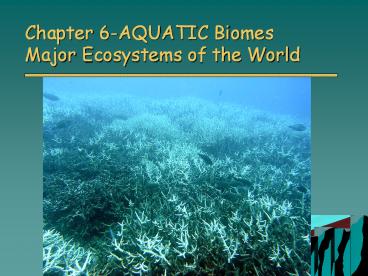Chapter 6-AQUATIC Biomes Major Ecosystems of the World - PowerPoint PPT Presentation
Title:
Chapter 6-AQUATIC Biomes Major Ecosystems of the World
Description:
Chapter 6-AQUATIC ENVIRONS Major Ecosystems of the World Earth s Major Biomes Biome A large, relatively distinct terrestrial region with a similar climate soil ... – PowerPoint PPT presentation
Number of Views:402
Avg rating:3.0/5.0
Title: Chapter 6-AQUATIC Biomes Major Ecosystems of the World
1
Chapter 6-AQUATIC BiomesMajor Ecosystems of the
World
2
Questions of the day
- Name five unique characteristics of aquatic
biomes. - Name some adaptations of aquatic organisms.
- Name two-three human impacts on aquatic systems.
3
Great Barrier Reef
- http//www.npr.org/blogs/parallels/2014/10/28/3532
90458/as-great-barrier-reef-ails-australia-scrambl
es-to-save-it
4
Earths Major Biomes
- Biome
- A large, relatively distinct terrestrial region
with a similar climate soil, plants, and animals,
regardless of where it occurs in the world - Nine major biomes
- Location of each biome is primarily determined
by - Temperature (varies with both latitude and
elevation) - Precipitation
- Biomes can also be defined by
- Winds, rapid temperature changes, fires, floods,
etc.
5
(No Transcript)
6
Aquatic Ecosystem
- Fundamental Division
- Freshwater
- Saltwater
- Aquatic Ecosystems also affected by
- Dissolved oxygen level, light penetration, pH,
presence/absence of currents - Three main ecological categories of organisms
- Plankton- free floating
- Nekton- strong swimming
- Benthos- bottom dwelling
7
Freshwater Ecosystems
- Includes
- Rivers and streams (lotic)
- Lakes and ponds (lentic)
- Marshes and swamps
- Represent 2 of earths surface
- Assist in recycling water back to the oceans
8
Rivers and Streams
- Changes greatly from headwater to mouth
- Headwaters
- Shallow, cool, swiftly flowing, high oxygenated
- Mouth
- Not as cool, slower flowing, less oxygen in water
9
(No Transcript)
10
Lakes and Ponds
- Body of freshwater that does not flow
- Three zones
- Littoral
- Limnetic
- Profundal
- Experience thermal stratification (depending on
depth)
11
(No Transcript)
12
Lakes and Ponds
- Littoral Zone - shallow water area along the
shore - Limnetic Zone - open water beyond the littoral
zone - Profundal Zone - beneath the limnetic zone of
deep lakes
13
Thermal Stratification
- Temperature changes sharply with depth
- Thermocline
- Temperature transition between warmer surface
water and colder water at depth - Only present in warm months
14
Fall Turnover
15
Wetlands
- Examples marshes, swamps, bogs
- Lands that shallow, fresh water covers for at
least part of the year - Characteristic soil- water logged and anaerobic
for periods of time
- Water tolerant vegetation
- Were once regularly filled in
- More recently their ecosystem services have been
better recognized - Flood protection, water
filtering, etc.
16
(No Transcript)
17
Everglades
- What do you know about the everglades?
- What kinds of animals live there?
- Has anyone ever been to the everglades?
18
Check this out!
19
Estuaries
- Where freshwater and saltwater mix
- Highly variable environment
- Temperature, salinity, depth of light penetration
- Highly productive
- Nutrients transported from land
- Tidal action promotes rapid circulation of
nutrients - High level of light penetrates shallow water
- Many plants provide photosynthetic carpet
20
Marine Ecosystems
- Subdivided into life zones
- Intertidal zone
- Benthic zone
- Pelagic environment
- Neritic Province
- Oceanic Province
21
Marine Ecosystems
22
Intertidal Zone
- Area of shoreline between low and high tides
- Habitat
- Sandy or rocky
- Muscles
- Crabs
- Algae
- Oysters
- Barnacles
- Animals must adapts to changing conditions
23
Benthic Zone
- Ocean floor, extending from tidal zone to deep
sea trenches - Sediment is mostly mud
- Burrowing worms and clams
- Three zone
- Bathyal 200m - 4000m deep
- Abyssal 4000m -6000m deep
- Hadal 6000m bottom of deep sea trenches
24
Sea grass beds
25
Kelp forests
26
Coral Reefs
27
Productive Benthic Communities
- Seagrass Beds
- Present to depth of 10 m
- Provide food and habitat to ecosystem
- Kelp Forest
- 60-m long brown algae found off rocky shores
- Diversity of life supported by kelp rivals coral
reefs - Coral Reefs
- Built from accumulated layers of CaCO3
- Colonies of millions of tiny coral animals
- Found in shallow warm water
- Most diverse of all marine environments
28
Productive Benthic Communities
Left Seagrass Bed
Right Kelp Forest
29
Coral Reef Environments
- Three types of coral reefs
- Fringing reef- directly attach to continent- no
lagoon - Atoll- circular reef in a lagoon
- Barrier reef- separates lagoon from ocean
30
Human Impact on Coral Reefs
- Sedimentation
- From clear-cutting upstream
- Overfishing
- Coral bleaching
- Mining of corals as building materials
- Runoff pollution
31
Pelagic Environment
- All the open ocean water
- Two main divisions
- Neritic Province
- Water that overlies the continental shelf (to
depth of 200 m) - Organisms are all floaters or swimmers
- Oceanic Province
- Water that overlies depths greater than 200 m
- 75 of worlds ocean
- Most organisms are dependent on marine snow
- Organisms are filter feeders, scavengers and
predators
32
Human Impacts on the Ocean































